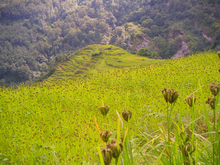| Chloridoideae | |
|---|---|

| |
| Finger millet (Eleusine coracana) in Nepal | |
| Scientific classification | |
| Kingdom: | Plantae |
| Clade: | Tracheophytes |
| Clade: | Angiosperms |
| Clade: | Monocots |
| Clade: | Commelinids |
| Order: | Poales |
| Family: | Poaceae |
| Clade: | PACMAD clade |
| Subfamily: | Chloridoideae Kunth ex Beilschm. |
| Tribes | |
Chloridoideae is one of the largest subfamilies of grasses, with roughly 150 genera and 1,600 species, mainly found in arid tropical or subtropical grasslands. Within the PACMAD clade, their sister group is the Danthonioideae.[1] The subfamily includes widespread weeds such as Bermuda grass (Cynodon dactylon) or goosegrass (Eleusine indica), but also millet species grown in some tropical regions, namely finger millet (Eleusine coracana) and teff (Eragrostis tef).
With the exception of some species in Ellisochloa and Eleusine indica, most of the subfamily's species use the C4 photosynthetic pathway[citation needed]. The first evolutionary transition from C3 to C4 photosynthesis in the grasses probably occurred in this subfamily, around 32 to 25 million years ago in the Oligocene.[2]